

Bring Clarity to your Canvas Course Part 1: Cours... - Canvas Community. Photo by Luis Guerrero on Unsplash.

Bring Clarity to your Canvas Course Part 2: Modul... - Canvas Community. Bring Clarity to your Canvas Course:Course Navigation + Modules + Home Page Part 2: Modules Photo by Paweł Czerwiński on Unsplash Hello, I am the Learning Management System Specialist in our K12 district and I provide support and instruction to our teachers and staff in the use of Canvas, promoting consistency, efficiency, and effectiveness.
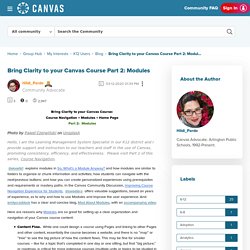
Please visit Part 1 of this series, Course Navigation. explains modules in So, What’s a Module Anyway? Bring Clarity to your Canvas Course Part 3: Home ... - Canvas Community. Bring Clarity to your Canvas Course:Course Navigation + Modules + Home Page Part 3: Home Page Photo by Nathan Fertig on Unsplash Hello, I am the Learning Management System Specialist in our K12 district and I provide support and instruction to our teachers and staff in the use of Canvas, promoting consistency, efficiency, and effectiveness.

Please visit the other two parts of the blog series: Part 1: Course Navigation, and Part 2: Modules. As a K12 district we mostly have year-long courses. Here are my tips for having a useful and effective Home Page. Reduce redundancy by not including links on your Home Page to items that already exist in your Global Navigation or Course Navigation. Here is an image of a sample Home Page. In our district we are working on having more consistency across courses. 7 Guidelines for Setting Up Clear Online Lessons. When our classrooms moved online this year, many of us scrambled to find ways to engage students with lessons remotely, only to find that it was no simple task.
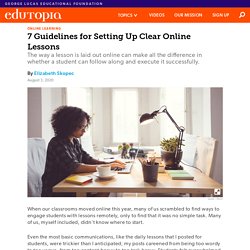
Many of us, myself included, didn’t know where to start. Even the most basic communications, like the daily lessons that I posted for students, were trickier than I anticipated; my posts careened from being too wordy to too vague, from too content-heavy to too task-heavy. Students felt overwhelmed by their new, independent workload, and I wasn’t streamlining our learning effectively. It just wasn’t easy to transform a 50-minute lesson into a clear, pithy post that would serve my high school students. Fortunately, my students weren’t shy about giving feedback that helped me hone my daily posts, and over time, I was able to make my lessons more navigable, readable, and engaging. Differentiating Assignments (k-12) in Canvas: Help... - Canvas Community. Differentiated instruction allows teachers to tailor study to a student's needs and/or interests.

Nothing is more frustrating than having to watch a student who has easily mastered the material not be challenged as he/she waits for others to grasp the material or to watch a student struggle so intensely with a concept that he/she continues to fall behind. Canvas makes approaching differentiated instruction easy, and that is always good news for teachers who often feel pulled in multiple directions in any given class period.
Reach both the soaring and struggling student at the same time! Below are several strategies to leverage differentiated instruction in your classroom through Canvas! Individualization in Assignments One of the key features of Canvas is the ability to assign one assignment to individual students. Exempting Students Instructors can exempt students from assignments in the gradebook by entering "EX" in the gradebook cell. Extended Due Dates Extra Quiz Attempts Student Choice. Why We Need Differentiation Now More Than Ever. Assessment Trends In Education: A Shift To Assessment For Learning.
Assessment Trends In Education: A Shift To Assessment For Learning contributed by Trenton Goble, VP, K-12 Learning, Instructure Throughout the K-12 learning landscape, assessment practices are changing to embrace assessment for learning, not assessment of learning.

Consistent with 21st Century learning and the benefits brought on by better assessment tools, assessment is becoming more student-centric, offering educators the insights that will help them determine the best instructional next steps and how to make learning more personal for the individual student. Trading the punitive elements of policies like No Child Left Behind for the growth mindset presented in the Every Student Succeeds Act (ESSA), states are now able and incented to take advantage of alternatives to the expensive, high-stakes, end-of-level tests that have persisted for decades despite providing little benefit to the students. Assessment and the Little People - Canvas Community. Getting assessment right can be a challenge.
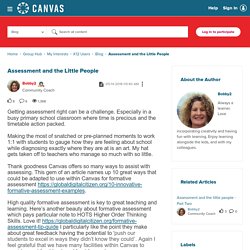
Especially in a busy primary school classroom where time is precious and the timetable action packed. Making the most of snatched or pre-planned moments to work 1:1 with students to gauge how they are feeling about school while diagnosing exactly where they are at is an art. My hat gets taken off to teachers who manage so much with so little. Meeting Accessibility in Your Canvas Course: Recommendations and Resources. Studio. Copyright Resources - Canvas Community. I'm collaborating with some fantastic colleagues (hat tips to and Lily Philips - Instructional Designers) to create an AMAZING resource we'll be sharing with the community, a Quality Canvas Course Checklist (link coming soon).

A quality Canvas course abides by copyright law and takes into consideration nature of the use, nature of the work used, extent of the use, and use’s economic effect. In my experience, educators want to abide by copyright law, but could often benefit from a refresher on copyright law and what constitutes a copyright infringement. TEACHing from a Distance and Copyright Considerations. Copyright law has tools specifically intended for distance learning, along with other tools such as fair use.
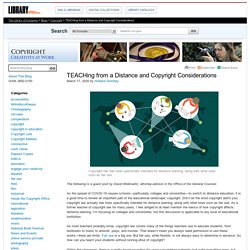
The following is a guest post by David Welkowitz, attorney-advisor in the Office of the General Counsel. As the spread of COVID-19 causes schools—particularly colleges and universities—to switch to distance education, it is a good time to review an important part of the educational landscape: copyright. Don’t let the word copyright alarm you; copyright law actually has tools specifically intended for distance learning, along with other tools such as fair use. As a former teacher of copyright law for many years, I feel obliged to at least mention the basics of how copyright affects distance learning. I’m focusing on colleges and universities, but this discussion is applicable to any level of educational institution. Copyright and Fair Use Animation.
How to Forge a Strong Community in an Online Classroom. When I moved a large part of my curriculum online a decade ago, I had to become more flexible and creative in my teaching.
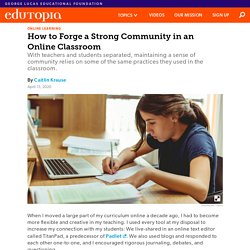
I used every tool at my disposal to increase my connection with my students: We live-shared in an online text editor called TitanPad, a predecessor of Padlet. We also used blogs and responded to each other one-to-one, and I encouraged rigorous journaling, debates, and questioning. I changed grading to verbal feedback, conversations, and self-assessments through reflections, and I flipped the majority of readings and longer writing exercises into asynchronous modes. The learning space bloomed—and not because of the tech. It bloomed because of our mutual care and enthusiasm for the community connection. I share five methods here that I have found useful for building or maintaining a strong sense of community. 1. I’ve seen many articles that put self-care at the end of a long list of tips and considerations for educators.
6 Ideas for Creating a Remote Community of Learners. As we move to remote learning much attention has been paid to teachers connecting with students, which is extremely valuable and important. In addition to teacher and student connection, peer collaboration is important for learning and social-emotional well-being. What Do Safe, Respectful and Inclusive Virtual Classrooms Look Like?
As teachers head back to school—whether that is in person, online or a hybrid model—fostering a safe, respectful and inclusive classroom is as important as ever. How do safe and inclusive classroom practices apply to digital spaces and what can educators do to establish those norms and carry them out throughout the year? Just as you create safe, respectful and equitable physical classroom spaces, many of us are learning how to bring those best practices online. Our list of suggested strategies is long. That’s why our first tip is to start by selecting one or two items that are most relevant for your setting and teaching goals.